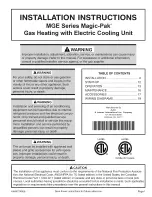
A
DJ & DG MANUAL
23 of 34
May 12 R2
COMBUSTION AND FINAL UNIT CHECK FOR UNITS WITHOUT TRAC CONTROLS
The heater has been test fired in the factory for firing rate and combustion. Field conditions may require
small adjustments to be made. These checks should be done by a qualified service man.
1.
When the main flame is established, check the gas manifold pressure at the test point nearest the
burner with the unit operating at high fire. Check the name plate for the correct manifold pressure
and adjust the appliance regulator if necessary. The unit inlet gas pressure should not go below the
minimum pressure shown on the nameplate when at high fire. Ensure that the temperature rise
does not exceed nameplate.
2.
Check CO and O
2
reading at maximum and minimum inputs shown on name plate. CO should
generally not be above 200 ppm and a very maximum of 300 ppm. O
2
reading should range from
3 1/2% to 4% at high fire on all units. Low fire combustion values are found on the table below for
units that have constant combustion air or variable combustion air damper.
Model of Unit
Type of burner
Shape of burner
Low Fire % of max
O
2
Reading
DJ w/ Constant
Combustion Air
Standard
Round
60%
10 –11.5%
DG
Model B or R Gorden Piatt
Round (painted blue)
50%
10%
For units with G-TRAC, G-TRAC2, DJM, DJM-2, DJM-3 and X-TRAC controllers refer to
Combustion Set-Up section in the Installation, Operation and Maintenance Manuals for the
respective controls.
3.
Check flue outlet pressure on indoor unit to make sure that it does not exceed the maximum shown
on the nameplate. (See maximum overfire pressure).
4.
When the unit start up is complete, re-check the amperage draw of each motor (i.e., after an air
balance).
5.
Ensure that the safety controls are operative, i.e., flame ignition control, high limit, etc. (See
specification sheets on all controls). Recheck setting of all limits and temperature controls.












































